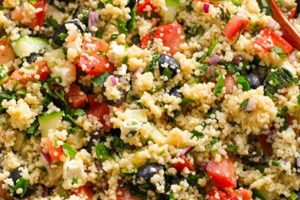A preparation of cooked, flaked whitefish combined with mayonnaise, often including seasonings such as celery, onion, herbs, and spices, constitutes a classic dish. Variations exist, incorporating ingredients like lemon juice, capers, or hard-boiled eggs. This dish can be served as a sandwich filling, appetizer spread, or salad topping.
This versatile dish offers a good source of protein and omega-3 fatty acids. Historically, similar preparations have existed for centuries as a method of preserving and utilizing readily available fish. Its adaptability to diverse flavor profiles and ease of preparation contribute to its continued popularity. From simple home kitchens to upscale restaurants, this dish finds its place across culinary landscapes.
The following sections delve further into specific preparation methods, nutritional information, and creative serving suggestions.
Tips for Preparing Whitefish Salad
Optimizing the preparation of this dish involves attention to detail and selection of high-quality ingredients. The following tips offer guidance for achieving superior results.
Tip 1: Fresh, High-Quality Fish: Begin with the freshest whitefish available. Wild-caught options often offer a richer flavor profile. Ensure proper handling and storage prior to preparation.
Tip 2: Gentle Cooking: Overcooking results in dry, tough fish. Poaching or baking are recommended methods for maintaining moisture and delicate texture.
Tip 3: Thorough Flaking: Once cooked and cooled, flake the fish carefully, avoiding large chunks. This promotes even distribution throughout the salad and enhances the overall texture.
Tip 4: Balanced Flavor Profile: Mayonnaise serves as the foundation, but the addition of complementary ingredients elevates the dish. Finely diced celery, red onion, and fresh herbs create a balanced flavor profile.
Tip 5: Seasoning with Care: Salt and freshly ground black pepper are essential. Consider adding a touch of lemon zest, Dijon mustard, or capers for added complexity.
Tip 6: Chilling Time: Allowing the salad to chill for at least 30 minutes before serving allows the flavors to meld and enhances the overall experience.
Tip 7: Creative Serving Options: Explore beyond the traditional sandwich. Serve the salad on crackers, lettuce cups, or as a filling for deviled eggs.
Careful consideration of these tips yields a whitefish salad that is both flavorful and texturally appealing. By focusing on quality ingredients and mindful preparation techniques, one can create a truly satisfying culinary experience.
By implementing these suggestions, culinary enthusiasts can consistently achieve a delectable and satisfying outcome when preparing this classic dish. The following section provides concluding thoughts.
1. High-quality whitefish
The foundation of a successful whitefish salad rests upon the selection of high-quality fish. The inherent characteristics of the fish significantly influence the final flavor, texture, and overall quality of the salad. Understanding the nuances of selecting appropriate whitefish is essential for achieving optimal results.
- Species Selection
Various species qualify as whitefish, each possessing unique flavor profiles and textures. Common choices include cod, haddock, pollock, and whiting. Denser, flaky varieties like cod hold their shape well in a salad, while more delicate options like whiting offer a milder taste. Choosing the correct species aligns the final product with desired flavor and textural outcomes. For instance, smoked haddock adds a robust smoky flavor, while a mild flaky cod provides a neutral base for other ingredients to shine.
- Freshness Indicators
Freshness is paramount. Indicators of fresh whitefish include a clean, slightly sweet aroma, firm flesh, and clear, bright eyes. Avoiding fish with a strong fishy odor, dull appearance, or mushy texture is crucial. Freshness directly correlates with the overall quality and safety of the final salad. Sourcing fish from reputable fishmongers ensures access to higher-quality products with verifiable freshness.
- Sourcing Practices
Understanding sourcing practices offers insight into the quality and sustainability of the chosen fish. Sustainably sourced fish minimizes environmental impact and often correlates with higher quality due to responsible fishing practices. Considering factors like wild-caught versus farmed and the specific fishing methods employed informs conscious consumption. Supporting sustainable fisheries contributes to the long-term health of ocean ecosystems.
- Preparation Method’s Impact
The method used to cook the whitefish for the salad impacts the final result. Poaching or baking preserves moisture and delicate flavors, while grilling or frying can impart stronger, potentially overpowering, tastes. Aligning the cooking method with the desired flavor profile of the finished salad is crucial. For example, poaching cod in a court bouillon with herbs infuses subtle flavors, while pan-frying can create a crispier texture less suited for a traditional salad.
The selection of high-quality whitefish is integral to crafting a superior whitefish salad. Considerations of species, freshness, sourcing, and preparation method each contribute significantly to the final outcome. By prioritizing these aspects, one ensures a delectable and satisfying culinary experience. The delicate balance of flavors and textures within a well-made whitefish salad directly reflects the quality of its core ingredient.
2. Proper cooking technique
Proper cooking technique is paramount in achieving a palatable whitefish salad. The cooking method directly impacts the fish’s texture, moisture content, and overall flavor, which are critical components of a successful salad. Overcooked fish becomes dry and stringy, resulting in a less desirable final product. Conversely, undercooked fish presents food safety concerns. Appropriate cooking ensures both palatability and safety. Poaching or baking are generally preferred methods due to their gentle nature, preserving the fish’s delicate texture and moisture. For example, poaching in a flavorful court bouillon infuses subtle seasonings while maintaining the fish’s integrity. Baking, particularly en papillote, offers similar benefits, sealing in moisture and allowing for nuanced flavor development.
The impact of cooking technique extends beyond the immediate characteristics of the fish. It also influences how the fish interacts with other salad ingredients. Properly cooked, flaky whitefish readily absorbs the flavors of the dressing and other components, creating a cohesive and harmonious blend. Overcooked fish, however, struggles to absorb these flavors, resulting in a disjointed and less satisfying experience. Consider the difference between a salad made with dry, overcooked fish and one made with moist, delicately poached fish. The former often lacks the integrated flavor profile characteristic of a well-made whitefish salad, while the latter allows the flavors of the fish, dressing, and other ingredients to meld seamlessly.
Mastery of proper cooking techniques is therefore essential for creating a high-quality whitefish salad. It is not merely a step in the process but rather a foundational element that significantly influences the final dish. Choosing the appropriate cooking method, such as poaching or baking, and executing it correctly ensures the fish retains optimal texture and moisture, ultimately leading to a more flavorful and enjoyable salad. This understanding allows for a more nuanced approach to recipe development and execution, resulting in a superior culinary experience.
3. Flavorful additions
Flavorful additions elevate whitefish salad beyond a simple combination of fish and mayonnaise. These additions introduce complexity, balance, and textural contrast, transforming the salad into a more dynamic and satisfying dish. Careful consideration of complementary flavors and textures is crucial for achieving a well-rounded and appealing result. The strategic incorporation of these elements distinguishes a truly exceptional whitefish salad from a mediocre one.
- Aromatic Vegetables
Aromatic vegetables, such as finely diced celery, red onion, and shallots, contribute a refreshing crispness and subtle pungency. These elements provide textural contrast to the flaked fish and a depth of flavor that complements the richness of the mayonnaise. For example, the slight bitterness of red onion balances the creamy dressing, while celery adds a refreshing crunch. The careful balance of these aromatics prevents any single flavor from overpowering the delicate taste of the whitefish.
- Fresh Herbs
Fresh herbs introduce bright, herbaceous notes that enhance the overall flavor profile. Dill, parsley, chives, and tarragon are popular choices, each offering unique characteristics. Dill, with its slightly anise-like flavor, pairs particularly well with richer fish like salmon or trout, while parsley provides a clean, fresh taste. The choice of herbs should complement the other ingredients and the desired overall flavor profile. For instance, a Mediterranean-inspired salad might incorporate oregano and mint, while a classic preparation might stick to dill or parsley.
- Acidic Components
A touch of acidity brightens the flavor of the salad and cuts through the richness of the mayonnaise. Lemon juice, vinegar, or capers provide a welcome tartness that balances the other ingredients. Lemon zest can further enhance the citrus notes, adding a fragrant dimension. The judicious use of acid prevents the salad from becoming overly heavy or cloying. A squeeze of fresh lemon juice can transform a bland salad into a vibrant and refreshing dish.
- Spices and Seasonings
Spices and seasonings add depth and complexity to the salad. A pinch of cayenne pepper introduces a subtle heat, while smoked paprika adds a smoky dimension. Black pepper is essential for enhancing the overall flavor profile. The choice of spices depends on the desired flavor profile and can range from classic combinations to more adventurous blends. For example, a traditional New England style whitefish salad might include Old Bay seasoning, while a more contemporary version might incorporate curry powder or cumin.
The considered inclusion of flavorful additions elevates whitefish salad from simple to exceptional. The interplay of textures, aromas, and tastes creates a balanced and harmonious dish that is greater than the sum of its parts. By thoughtfully selecting and incorporating these elements, one can create a whitefish salad that is both delicious and memorable. A well-crafted whitefish salad demonstrates the transformative power of carefully chosen ingredients working in concert to create a truly satisfying culinary experience.
4. Balanced Seasoning
Balanced seasoning is crucial for a successful whitefish salad. It directly impacts the final flavor profile, enhancing the delicate taste of the fish without overpowering it. The interplay of salt, pepper, and other spices creates depth and complexity. Over-seasoning can mask the subtle flavors of the whitefish, while under-seasoning results in a bland and unappealing dish. The goal is to achieve a harmonious blend where each seasoning complements the others and enhances the overall taste experience. For instance, a classic preparation might use a simple combination of salt, black pepper, and a touch of lemon zest. The salt enhances the natural flavors of the fish, while the pepper adds a subtle bite, and the lemon zest provides a hint of brightness. Alternatively, a more complex flavor profile might incorporate smoked paprika, dill, and cayenne pepper for a smoky, herbaceous, and subtly spicy salad.
The importance of balanced seasoning extends beyond simply adding flavor. It also plays a critical role in the overall texture and moisture perception of the salad. Salt, in particular, affects the protein structure of the fish, influencing how it binds with moisture. Proper salting helps retain moisture, resulting in a more tender and succulent salad. Furthermore, the right balance of seasonings can create a more cohesive blend of flavors, where the fish, dressing, and other ingredients meld seamlessly. Consider the difference between a salad seasoned solely with salt and one that incorporates a balanced blend of salt, pepper, and other spices. The latter offers a more nuanced and satisfying flavor experience, where each ingredient contributes to the overall taste.
Achieving balanced seasoning requires careful consideration and attention to detail. It involves understanding the interplay of different flavors and how they interact with the delicate taste of the whitefish. It also requires adjusting seasoning levels based on the other ingredients in the salad. A salad with bolder flavors, such as capers or olives, might require less seasoning than a simpler preparation. Mastering this aspect of recipe development is essential for creating a truly exceptional whitefish salad. The delicate balance of flavors achieved through thoughtful seasoning elevates the dish, transforming it from a simple combination of ingredients into a culinary delight.
5. Appropriate Chilling
Appropriate chilling is integral to a successful whitefish salad, significantly influencing both flavor development and food safety. Chilling allows the individual flavors of the ingredientsthe fish, aromatics, seasonings, and dressingto meld and harmonize, creating a more cohesive and complex flavor profile. This process of flavor integration is crucial for achieving a balanced and well-rounded taste. Without sufficient chilling time, the flavors remain distinct and disjointed, resulting in a less satisfying culinary experience. For example, a freshly made whitefish salad might taste predominantly of mayonnaise, with the other flavors playing a secondary role. After proper chilling, however, these flavors meld, creating a harmonious blend where the fish, aromatics, and seasonings shine through.
Beyond flavor development, appropriate chilling is essential for food safety. Whitefish salad, like other dishes containing mayonnaise, is susceptible to bacterial growth if left at room temperature for extended periods. Chilling inhibits bacterial growth, minimizing the risk of foodborne illness. Adhering to safe food handling practices, including proper chilling, ensures the salad remains safe for consumption. Practical applications include refrigerating the salad promptly after preparation and maintaining a consistent cold temperature during storage and serving. For instance, using a chilled serving bowl and avoiding prolonged exposure to room temperature during picnics or buffets are crucial for maintaining food safety.
In summary, appropriate chilling serves a dual purpose in whitefish salad preparation: it enhances flavor development and ensures food safety. The chilling process allows the individual flavors to meld, creating a more complex and satisfying taste experience. Simultaneously, it inhibits bacterial growth, safeguarding against foodborne illness. Understanding and applying this principle is essential for crafting a whitefish salad that is both delicious and safe to consume. The practical implications of appropriate chilling should not be underestimated; it is a critical step that contributes significantly to the overall quality and enjoyment of the dish.
Frequently Asked Questions
This section addresses common inquiries regarding the preparation and enjoyment of whitefish salad.
Question 1: What type of whitefish is best suited for this salad?
While various whitefish species work well, cod, haddock, and pollock are popular choices due to their firm texture and mild flavor. Smoked whitefish, such as smoked haddock or trout, offers a richer, smokier alternative.
Question 2: How long can whitefish salad be stored safely?
When properly refrigerated in an airtight container, whitefish salad typically remains safe for consumption for three to five days. Always check for signs of spoilage, such as a sour odor or discoloration, before consuming.
Question 3: Can whitefish salad be frozen?
Freezing is not generally recommended, as it can negatively impact the texture of the mayonnaise and fish, resulting in a watery consistency upon thawing. It’s best to prepare and consume the salad within a few days for optimal quality.
Question 4: What are some healthy alternatives to mayonnaise?
Greek yogurt or a mixture of Greek yogurt and mayonnaise offer a lighter, lower-fat alternative to traditional mayonnaise while maintaining a creamy texture. Avocado can also be used for a vegan option.
Question 5: How can one prevent the salad from becoming too watery?
Ensuring the fish is properly drained after cooking and using a thicker mayonnaise or Greek yogurt helps prevent excess moisture. Adding a small amount of finely diced celery or red onion also absorbs some liquid.
Question 6: What are some creative serving suggestions beyond sandwiches?
Whitefish salad can be served on crackers, lettuce cups, cucumber rounds, or as a filling for deviled eggs or baked potatoes. It can also be used as a topping for salads or incorporated into a wrap.
Understanding these key aspects ensures a safe and enjoyable culinary experience with whitefish salad.
This concludes the frequently asked questions section. The next section will offer concluding thoughts.
Conclusion
Preparation of whitefish salad involves a nuanced understanding of ingredient selection, cooking techniques, and flavor balancing. High-quality, fresh whitefish forms the foundation. Proper cooking methods, such as poaching or baking, ensure optimal texture and moisture retention. The incorporation of complementary ingredientsaromatic vegetables, fresh herbs, acidic components, and balanced seasoningselevates the dish beyond basic fish and mayonnaise. Appropriate chilling allows flavors to meld, enhancing the overall taste experience while ensuring food safety. Consideration of these elements contributes to a superior final product.
Culinary exploration of whitefish salad offers a rewarding experience. From classic preparations to innovative variations, the potential for creativity is vast. Emphasis on quality ingredients and thoughtful execution consistently yields a delectable and satisfying outcome. Further exploration of regional variations and flavor combinations provides opportunities for continued culinary discovery and enjoyment.






